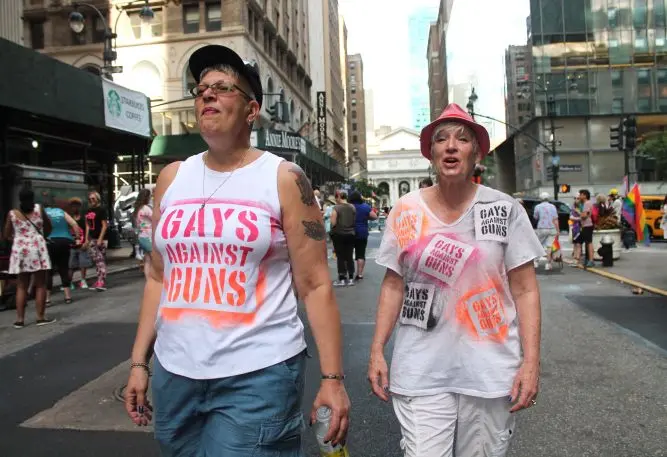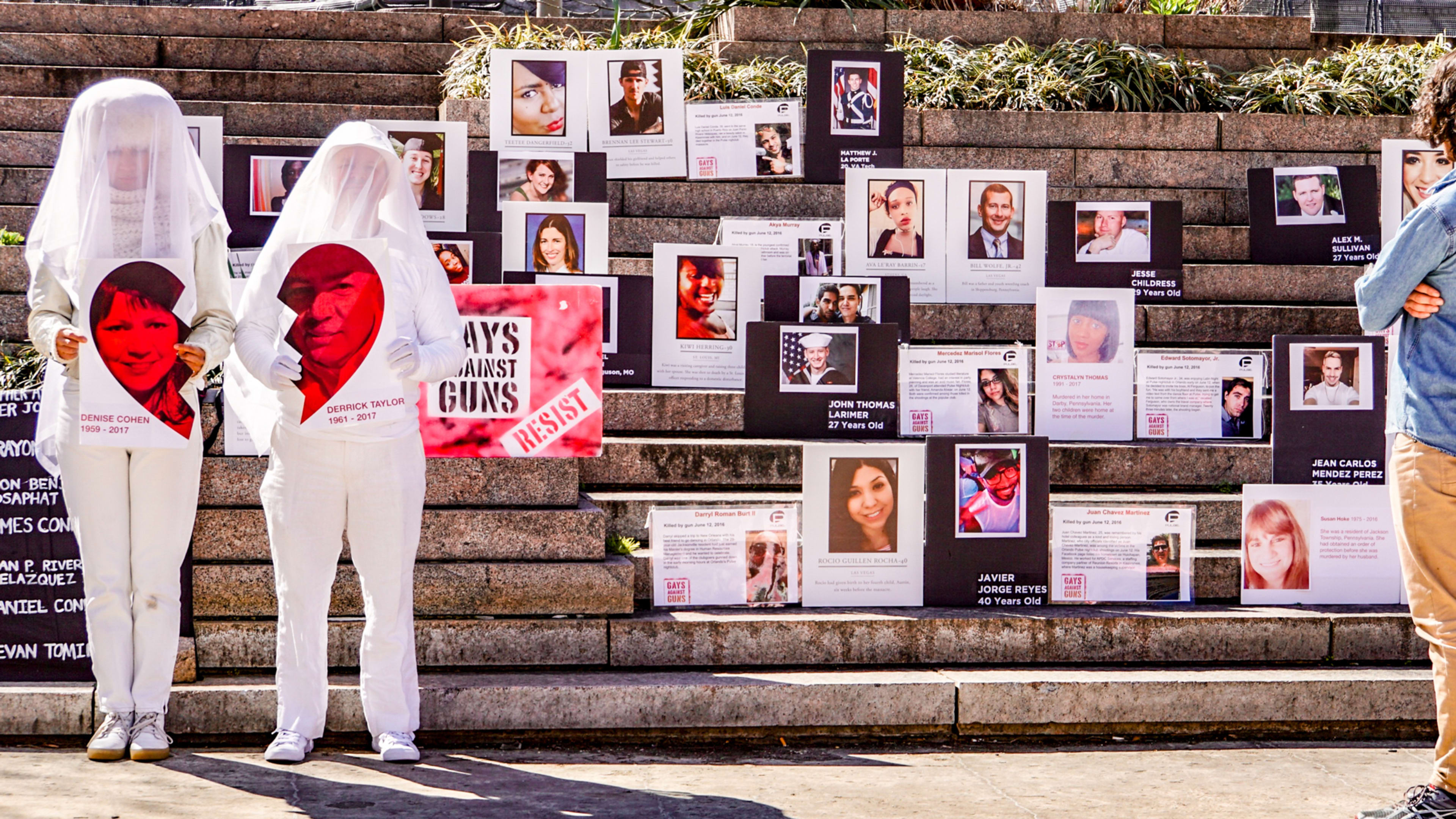Pulse changed my life. After an armed gunman killed 49 people and injured 53 others at the Orlando gay nightclub on June 12, 2016, I attended a vigil at the Stonewall Inn, which U.S. President Barack Obama would declare a national monument 12 days later. I shed my share of tears that night, and on the way home I grew angry. Five days afterward, a small group of activists and I cofounded Gays Against Guns (GAG), an inclusive, direct-action group of LGBTQ people and their allies committed to nonviolently breaking the gun industry’s chain of death.
Related: Four ways every company can advance LGBTQ rights in 2018
In the two years since, I’ve realized how many others feel as angrily as I did then–and still do. And I’ve never felt more optimistic that a diverse, inclusive coalition of Americans with radically different backgrounds and experiences can unite to change U.S. gun policy for good.

All about allies
Progressive movements are regularly (and sometimes rightly) criticized for infighting. Many struggle to build consensus and break down or burn out. This problem has arguably dogged the gun control movement for decades. But sadly, the sheer devastation wrought by gun violence in recent years has pushed the crisis into all corners of American life, often in deeply personal, intersecting ways.
I’m living proof of that. The Pulse massacre touched a collective memory of trauma suffered not just by the LGBTQ community, but also by other communities to which I belong. As a teacher, the shooting at Sandy Hook Elementary school on December 14, 2012, brought me literally to my knees. As a person of color, the shooting at the Emanuel African Methodist Episcopal Church in Charleston on June 17, 2015, shook my faith in humanity. Pulse also churned up personal memories of past experiences with gun violence: having a gun pulled on me at 19 and, a decade later, witnessing a teenager get shot by a peer during a street brawl.
Like so many of us that Pride month two years ago, I struggled to process what had happened in Orlando. It felt like there was was no such thing as a safe space anymore, and I couldn’t tolerate that. Time always feels short when you’re fighting to save lives, but in GAG’s short existence I’ve already seen what we can accomplish by banding together. Far from fighting for gun control as a “niche” community, or peeling away LGBTQ people who might otherwise gravitate toward existing organizations, GAG has helped funnel passionate queer and allied activists into the gun control movement–making it larger, stronger, and more effective.

Related: How the Parkland students are leading America beyond thoughts and prayers
We’ve built powerful strategic relationships with gun reform advocates like Representative Carolyn Maloney (D-NY) and New York City Public Advocate Letitia James. We also understand the intersectionality of gun violence. Some of us (myself included) are ACT UP veterans who see a correspondences between the public health crisis of AIDS and that of gun violence. We’ve marched twice in the Women’s March holding signage focused on domestic gun violence in particular. And recently, GAG joined Moms Demand Action and thousands of other activists in a Youth Over Guns march across the Brooklyn Bridge.
The necessity and power of coalition building–of just showing up–never ceases to amaze me. Despite the harsh context that brings us together, I’ve found that the gun violence prevention community is truly beautiful.
More hard work ahead
I know that we couldn’t have accomplished all that we have without these alliances. Through countless protests, actions, and events, we have named, blamed, and shamed gun manufacturers and investors, as well as the National Rifle Association (NRA) and its corporate and political backers, for their shared culpability in enabling gun violence. We’ve drawn attention to dangerous pending bills like the Concealed Carry Reciprocity Act, introduced in Congress last year. We have gone to Washington, D.C. (twice) to hand deliver letters to lawmakers who’ve earned “A+” ratings from the NRA, including Senators Marco Rubio (R-FL), Ted Cruz (R-TX), and John Cornyn (R-TX), demanding that they pass safer gun laws. We have been arrested in the Senate Hart Building for acts of civil disobedience.
So far, the marketplace has proved more responsive to pressure than the federal government has. GAG has held a 26-hour protest against FedEx for its business relationship with the NRA; the shipping company hasn’t changed its policies, but it’s lost partners as a result. Many other businesses, from banks to rental car companies, have distanced themselves from the gun lobby and changed their policies to make guns less accessible, without suffering catastrophic fallout among consumers.
Related: Brands still haven’t figured out how to talk to LGBTQ consumers
Some of the most powerful experiences I’ve had as a GAG organizer have occurred at a more intimate level, though. What often gets lost in conversations about movements seeking national change is how small communities of activists support one another throughout that process. Movements that may look fragmented or ragtag from the outside are often the most inclusive, supportive, and resilient.
That’s important, because the work we do with GAG is both energizing and exhausting. We’ve performed harm-reduction outreach at gun shows. We’ve participated in panels and events from coast to coast. We’ve held meetings every other week for two years, and held down full-time jobs all the while. And in the process, we’ve become a national group with thriving chapters. In short, we have not slept. Yet it’s our sense of community and shared purpose that not only keep us going as an organization, but helps us see how our work contributes to a movement that’s far larger than us.
June 24 will mark GAG’s third New York City Pride. That first year, with the Pulse massacre less than two weeks in the past, GAG member Tigger Ferguson conceived the idea of “Human Beings”: silent, veiled figures in white, each carrying placards bearing a photograph of someone killed by a gun. We sent 49 Human Beings down Fifth Avenue that year to commemorate the lives lost in Orlando. This year, there will be over 100 of them, representing the average 104 lives lost daily to gun violence–whether through police brutality, domestic abuse, mass shootings, or suicides.
Amid the music, whistles, and revelry, the Human Beings will memorialize the lives behind the devastating statistics we’re working to decrease. Nationwide over the past two years, there have been 110,980 gun violence incidents, 66,000 gun deaths, and 147,000 non-fatal shootings. I’ll keep fighting until all these figures fall to zero. And I know I’m not the only one who will, either.
John Grauwiler lives in New York City and teaches at the Bard High School for Early College Queens.
Recognize your brand’s excellence by applying to this year’s Brands That Matter Awards before the early-rate deadline, May 3.
